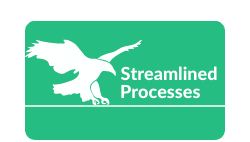For Crm For Process Improvement, see our main page here.
Why CRM Matters for Process Efficiency
Customer Relationship Management (CRM) isn’t just for sales and marketing. It’s a powerful engine for operational improvement. Whether you’re managing leads, client communications, or project workflows, a well-implemented CRM can streamline repetitive tasks and boost productivity.
Most importantly, CRM tools centralize data, so teams avoid duplication and delays. Instead of toggling between documents or chasing down updates, teams work from a shared source of truth. As a result, decisions are faster, customer interactions are more consistent, and outcomes improve steadily.
Leveraging CRM For Process Improvement in Real-World Scenarios
Let’s take a real-world example. A mid-sized IT services company struggled to manage its project lifecycle efficiently. Communication gaps between sales and delivery teams caused delays and client frustration. After implementing a CRM, the company set up triggered workflows that sent automatic handoff alerts when deals closed. Consequently, they eliminated 90% of transition errors within three months.
Similarly, a boutique legal firm used a CRM to reduce intake time by creating standardized onboarding forms. These forms fed directly into their case management system, which ensured lawyers had client details upfront. In the same vein, client satisfaction rose, and lawyers spent more time practicing law—not checking emails.
CRM systems let organizations identify bottlenecks. For example, if a service ticket lingers, managers can receive alerts, reassign work, or trigger escalation protocols. That flexibility provides immense value when workflows evolve with your business.
Key Features That Support Process Improvements
Not all CRMs are created equal. Look for these features if process improvement is your main goal:
- Workflow automation: Auto-route tasks, set reminders, and eliminate manual steps.
- Sales and service pipelines: Gain visibility into each deal or request’s progress.
- Custom reporting tools: Identify patterns and performance gaps over time.
- Third-party integrations: Connect your CRM to calendars, invoicing tools, or ERPs.
- Permissions and roles: Restrict access while maintaining collaboration across departments.
When used effectively, these tools reduce administrative effort and unlock time for higher-value work.
Mapping CRM Against Traditional Methods
Before CRMs became mainstream, teams relied heavily on spreadsheets, email chains, and manual data entry. While functional, these tools often led to missed deadlines and scattered files. In contrast, CRM systems centralize everything—and streamline updates in real time.
For instance, manually tracking a sales pipeline on a spreadsheet can result in duplicate entries, forecast errors, and lost leads. A CRM provides visual dashboards and automatic reminders, so users always know what needs attention. Therefore, less time is wasted pulling reports, and more time is spent closing deals or solving problems.
In industrial and service sectors alike, CRMs let leaders ensure that procedures are followed. Quality checks and approvals can be enforced by system logic, ensuring nothing slips through the cracks.
How Crm For Process Improvement Supports Team Collaboration
One of the unsung benefits of CRM systems is how they unify teams under a shared process. Marketing, sales, service, and operations all access the same real-time data. Consequently, fewer meetings are needed, and cross-functional alignment improves naturally.
Imagine a sales department promising a delivery within five days. The operations team, unaware of the commitment, schedules it for next week. With CRM integration, delivery dates, customer preferences, and exception notes are visible to all. Miscommunication vanishes, and customer trust deepens.
In addition, supervisors gain transparency into workload distribution. That means quicker conflict resolution, clear accountability, and better employee morale.
Metrics and KPIs: What to Track
To measure the impact of Crm For Process Improvement, select metrics that align with your goals. Here are some commonly used options:
- Cycle time: How long does it take to complete a process from start to finish?
- Lead response time: How quickly are inbound inquiries being addressed?
- Conversion rate: What percent of leads or tickets result in a closed outcome?
- Escalation frequency: Are delays or errors requiring management intervention?
- Automation rate: How many tasks are now triggered or completed automatically?
Furthermore, team feedback tools can give qualitative insights into whether processes are smoother. Consider regular internal surveys to evaluate perceived workflow efficiency before and after CRM rollout.
Common Challenges in CRM Adoption
Transitioning to a CRM can bring temporary friction. Employees may resist change or fear job automation. To ease the shift, involve teams early, offer hands-on training, and highlight how their daily work will improve. For example, customer service agents might welcome fewer repetitive tasks and more time to handle complex questions.
Another concern is data cleanliness. CRMs depend on accurate input; therefore, stale or duplicate data skews results. It’s essential to assign data stewards, implement validation rules, and schedule regular cleanups.
Lastly, over-customizing a CRM often backfires. Complex configurations can break as your business grows. Start with workflows that reflect core processes and evolve from there.
Industry Trends Shaping CRM for Operational Growth
CRM platforms continue to evolve with AI-powered tools leading the way. Predictive analytics now suggest next actions based on customer behavior. For example, a CRM can alert reps if engagement drops or if a renewal is due, so follow-ups are timely.
Moreover, mobile CRMs are gaining traction. Field teams can now update notes, accept approvals, or create tasks from their smartphones. That mobility helps maintain process flow outside the office.
Another fast-growing trend is industry-specific CRM solutions. From real estate to healthcare, niche CRMs offer pre-built templates tailored to vertical needs. Consequently, the implementation is faster and more efficient right out of the box.
FAQ: Applying Crm For Process Improvement
Q: Can small businesses benefit from process-focused CRMs?
A: Absolutely. Even solo entrepreneurs use CRMs to automate outreach, manage leads, and track job progress. Simple tools like Zoho CRM or HubSpot offer strong features at minimal cost.
Q: What’s the biggest mistake when using a CRM for workflow improvement?
A: Trying to replicate bad manual processes inside the system. CRMs work best when you simplify first, then automate.
Q: How do I know if my CRM is improving performance?
A: Track cycle times and task completion rates before and after implementation. Noticing fewer errors or missed deadlines? That’s a clear win.
Q: Are CRMs only useful for customer-facing tasks?
A: No. Internal operations like HR onboarding, purchase approvals, or vendor coordination also benefit from CRM workflows.
Make Smart Changes That Lead to Scalable Success
Crm For Process Improvement is not a one-time project—it’s a mindset. Think of it as building a living system that evolves with your business. Start small by automating predictable tasks. Then monitor results, gather feedback, and adapt. Over time, steady gains add up to significant improvement across departments.
This article was created with the assistance of AI tools and reviewed by our team at Streamlined Processes LLC to ensure accuracy and relevance.
Follow us on Facebook here.

